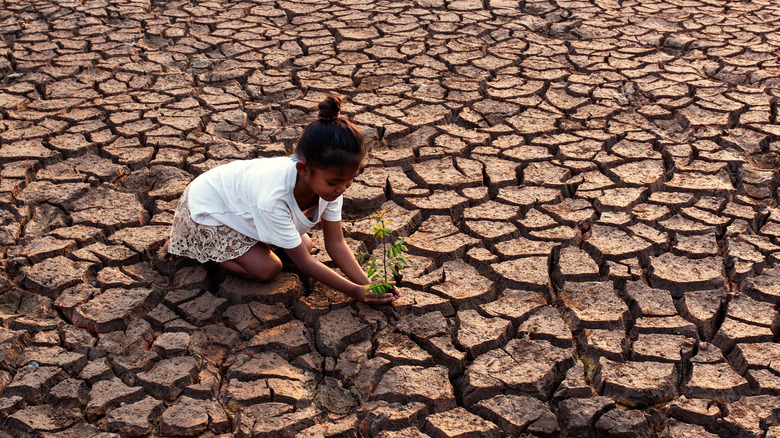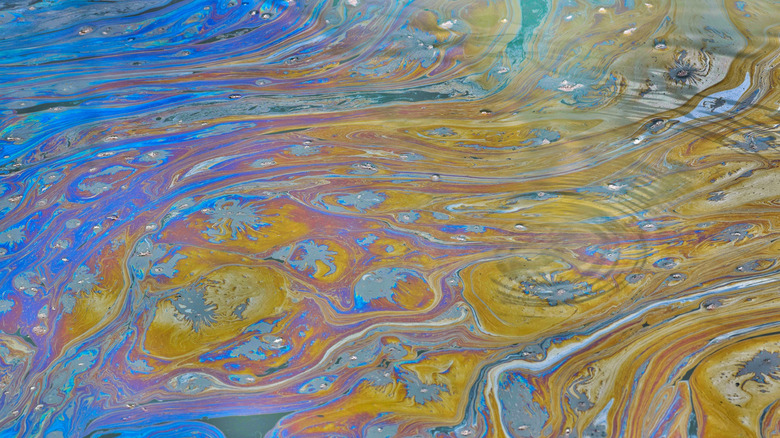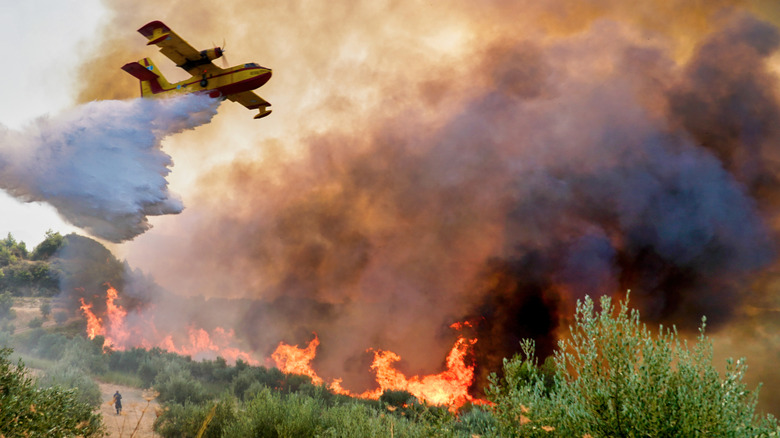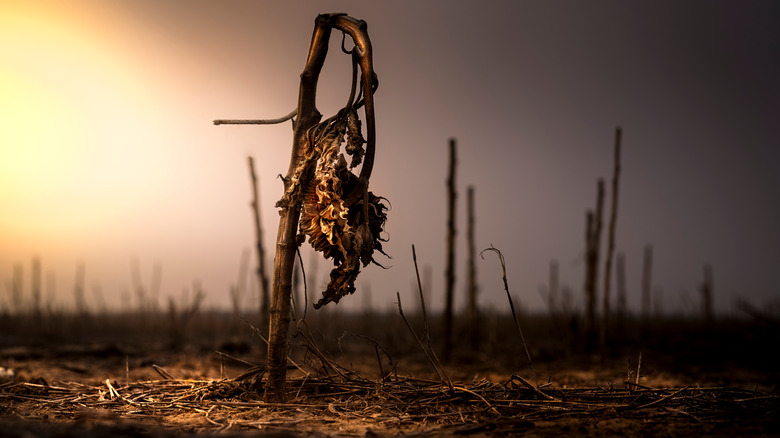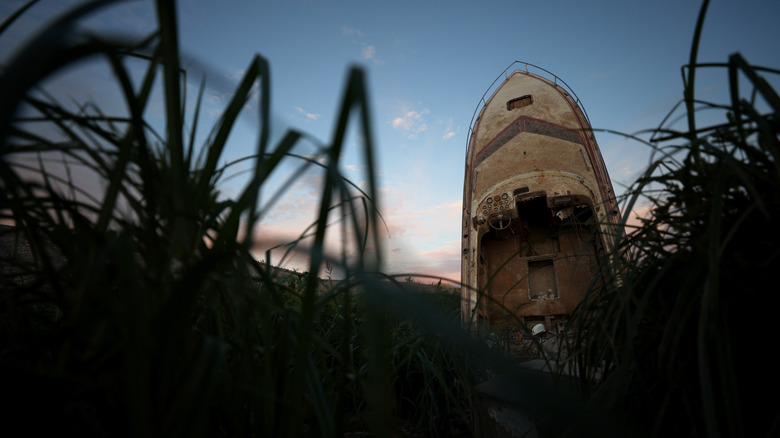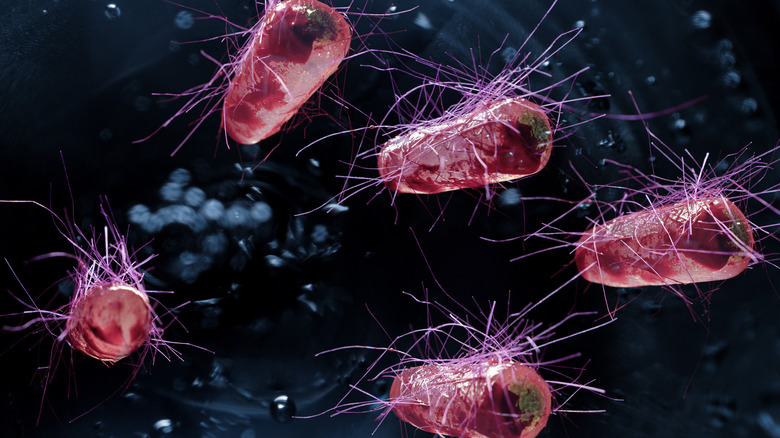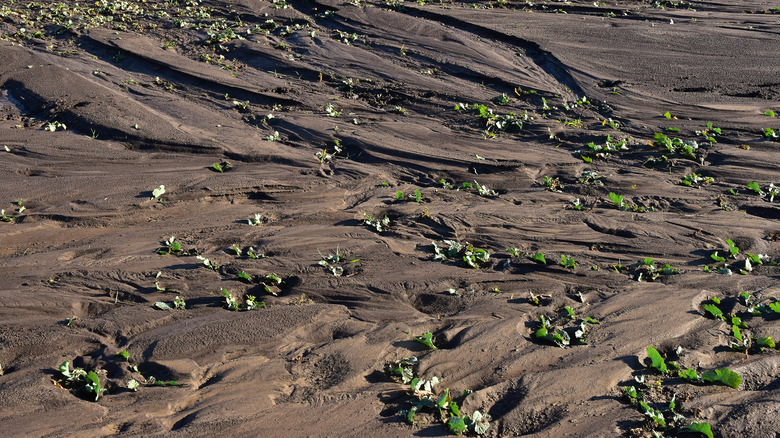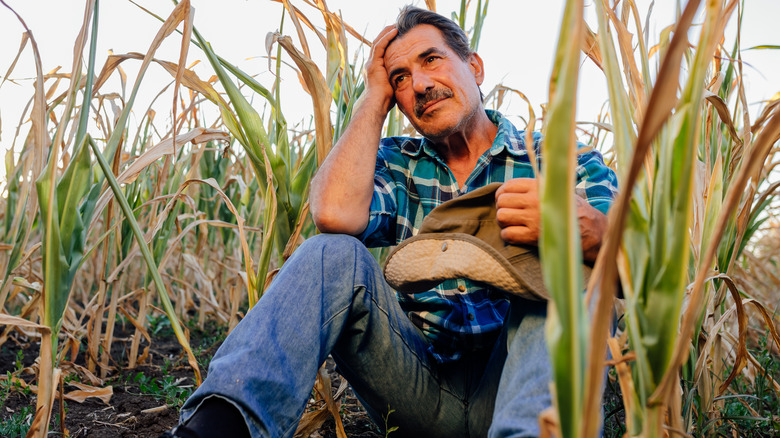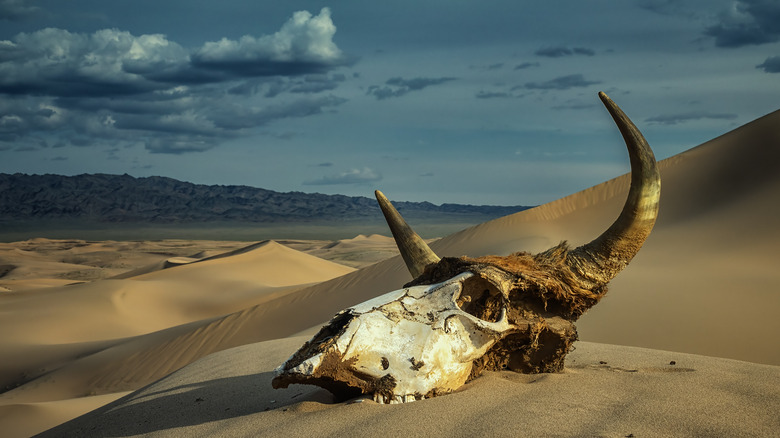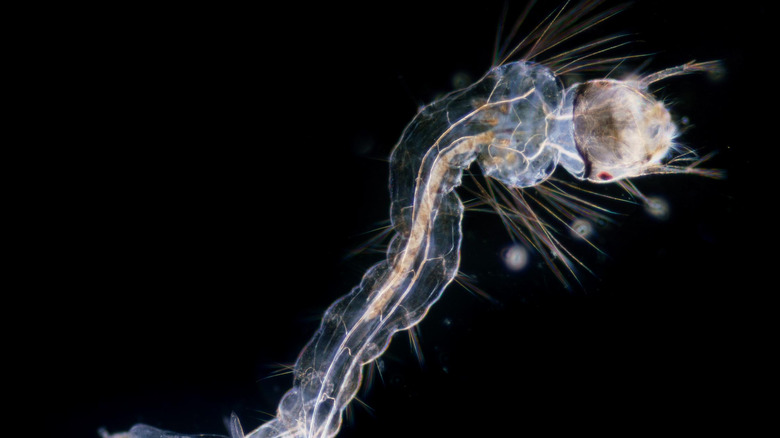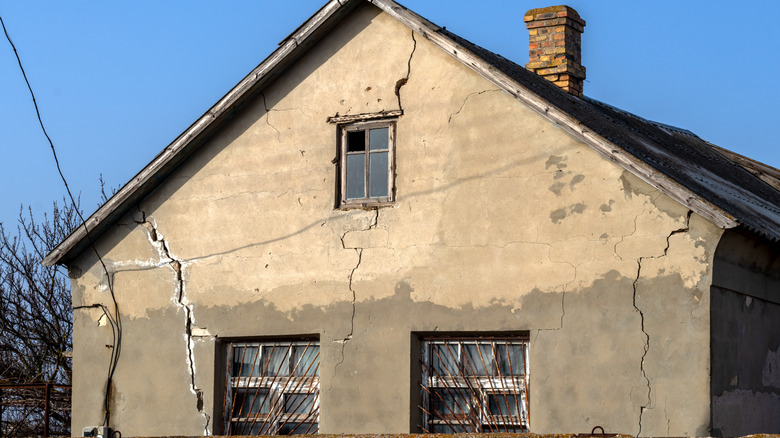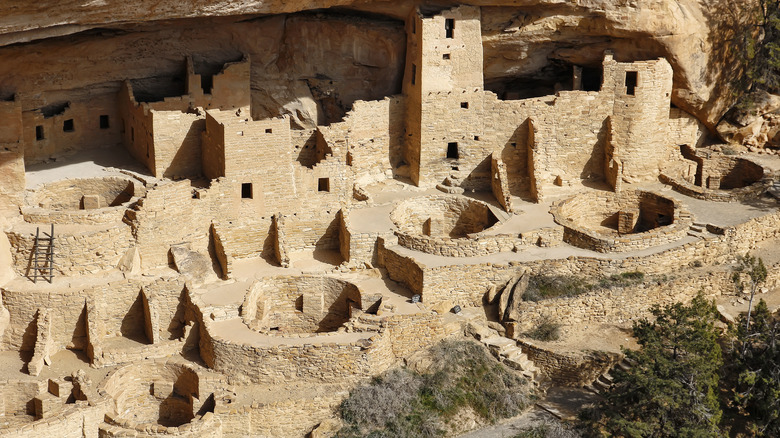What Really Happens During A Drought
In 2011, YouGovAmerica surveyed Americans about which natural disasters they most fear, and the results proved both revealing and a bit surprising. Of those polled, 71% actively worry about having their lives upended by a natural disaster. Among the most dreaded, tornadoes came in at 64% — not a huge shock considering their erratic nature and the well-publicized devastation left in their wake.
Trailing twisters, earthquakes ranked as a major concern for 40% of the people polled, followed by hurricanes at 33%. Among the other phenomena reported, 32% of participants worried about floods, tsunamis ranked next at 9%, and volcanic eruptions rounded out the list at 8%. Preppers are stocking up for such events as we speak (via The Guardian). But survey participants neglected to mention an ever-present natural disaster likely already impacting at least some of their daily lives: droughts. Shockingly, water shortages didn't even make the list.
Nevertheless, as anyone from the arid American West can attest, droughts represent life-changing events, wreaking havoc on farms and ranches, suburban neighborhoods, and major cities. Perhaps the reason for the oversight among those surveyed stems from a lack of familiarity with the consequences of droughts, especially in comparison to events like tornadoes and hurricanes. Here's what you need to know about what really happens during a drought and why it matters.
Water quality nosedives as currents stagnate and pollutants concentrate
On the one hand, climate change contributes to greater precipitation and more vegetation in some locations, which can translate into runoff and lake browning (via A Usable River Association). On the other hand, it can lead to the desertification of other regions, especially those located in the already-dry American West. Droughts can lead to diminished or vanished streams and waterways, which can have dangerous impacts on larger bodies of water.
The U.S. Geological Survey (USGS) explains, "Drought impacts streamflow, dissolved oxygen content, water quality, stream connectivity, available habitat, and other important freshwater habitat characteristics necessary for sustaining fish and invertebrate populations." Evaporation and lack of new water flow culminate in water stagnation and the buildup of pollutants, which devastate local ecosystems and wildlife.
These negative impacts on water quality can render whole bodies of water unlivable for species that previously made their homes there. Moreover, less water means higher salinity and increased water temperatures, according to a study published in Earth-Science Reviews. Algal bloom levels may also explode, transforming a once robust and resilient water system into a stagnant, deoxygenated dead zone.
Dust and wildfire smoke wreak havoc on air quality
Droughts make for arid conditions where plants and forests turn into standing tinderboxes just waiting for a stray spark to set them aflame, per the Centers for Disease Control and Prevention (CDC). This spark may come from an inadequately squelched campfire, a heedlessly tossed cigarette butt, or even a chain dragging behind a trailer on the highway, per Fox 10 Phoenix. No matter the cause, the consequences can prove devastating for hundreds of miles.
Wildfires put firefighters at risk as well as people, livestock, and wild animals in the area. What's more, as forests get consumed, pollutants and ash flood the atmosphere, reducing air quality and making people sick. The smoke can prove debilitating or even deadly for the most vulnerable individuals, such as people with asthma, heart disease, and other pulmonary conditions.
And wildland fire smoke isn't the only way that air quality can suffer. According to the CDC, dry vegetation and arid soil lead to ramped-up particulates in the air in the form of pollen and dust. No matter how you slice it, these particulates are harmful to the respiratory systems of animals and humans, causing various symptoms from coughing and wheezing to headaches, fatigue, an accelerated pulse, and shortness of breath.
Droughts destroy farms and ranches
Among the most feared and notorious aspects of a drought is a steep decline in agricultural production, per the USGS. After all, water shortages mean limited growing seasons and stunted produce. Crops aren't as healthy and remain more vulnerable to insects and disease. A lack of precipitation can also lead to other problems associated with water cycling, the breakdown of nutrients in the soil, and how much carbon remains in the ground, as reported by the National Integrated Drought Information System (NIDIS). Each of these factors can have a dramatic impact on what farms produce and how much.
Some aspects of drought are immediately recognizable. These involve issues like the desertification of pastureland. And crops lacking water fail to thrive and produce, per NIDIS. Tree nuts, vegetables, herbs, and fruits get hit especially hard. Moreover, regional lack of water leads to livestock malnourishment, disease, and fatalities.
A misconception exists that once the rain returns, things get back to business as usual. But drought paves the way for a long road to recovery. Years after soil moisture levels return to normal, deeper issues may persist. Ground and surface water levels can take years to recover, according to NIDIS. Rural areas and agricultural enterprises often rely on these water sources for irrigation, which can translate into long-term struggles and a double whammy for those who make a living through growing produce and animal husbandry.
Droughts put a damper on tourism and recreation
Nearly 3% of America's gross domestic product comes from tourism and another 2% from outdoor recreation (via the Bureau of Economic Analysis and NIDIS). But droughts can put a damper on things like jet skiing or downhill slaloms. These precipitation-dependent sports, along with fishing, boating, and snowboarding, take major hits when water shortages happen.
But dropping water levels can also mess with activities you might not associate with water, like hunting (due to alterations in wildlife behavior and migration) and camping. After all, nothing says camping like roasting marshmallows for s'mores over an open campfire. When the terrain dries out, however, you can kiss your campfires and melty marshmallows goodbye. It's simply too risky to light up, even inside a fire ring.
Pathogen and contaminant levels increase along with water temperature as water levels shrink, meaning greater exposure to bacteria, heavy metals, and chemicals. One example is the bacteria Naegleria fowleri, also known as brain-eating amoebas, which thrive in warmer water (via the CDC). These nasty microbes will make anybody think twice before getting into the water. Poor water quality can put a damper on fishing, swimming, boating, and water skiing, per the U.S. Department of Agriculture (USDA). The chances of boaters hitting dangerous debris at the bottoms of lakes also skyrocket. As the disappearance of Nevada's Lake Mead demonstrates, receding shorelines can even lead to unsavory discoveries like dead bodies, per NBC News. Unfortunately, brain-eating amoebas, deadly debris, and skeletons have a way of scaring away tourists.
Basic hygiene and sanitation go down the drain
People take water for granted, yet without it, life quickly gets very grim and very dirty, as reported by the United Nations Children's Fund (UNICEF). Diseases spread unchecked without enough water for sanitation, cleaning, and hygiene. Unsafe sanitation and water can lead to diarrhea and overall malnutrition, which can prove deadly, especially for children.
According to the UNICEF Director of Emergency Programs, Manuel Fontaine, "No matter how much food a malnourished child eats, he or she will not get better if the water they are drinking is not safe." Half of the world's malnutrition troubles stem from problems securing enough clean water for consumption and basic hygiene.
Climate Links elaborates on these findings, explaining that a majority of the globe's worst climate-based disasters stem from lack of water and drought. As droughts continue to ramp up in terms of length and severity, more people will suffer, especially the world's most vulnerable demographics like infants and kids. A lack of essential resources will lead to conflicts within communities, cities, and nations that can force the displacement of populations, further exacerbating droughts.
Lack of water contributes to rises in infectious diseases
Many experts believe that droughts will continue to increase in terms of severity and duration, as reported by the Public Library of Science. When water dries up, it contributes to increases in infectious diseases like cholera and E coli.
It also leads to increases in algal bloom, which spell trouble for marine life. Too much algae can force mass migrations and even cause die-offs, per the Environmental Protection Agency (EPA). Both micro- and macro-organisms pollute surface water and groundwater, inadvertently launching a vicious cycle of contamination of the remaining resources. These factors may even launch infectious disease outbreaks.
CBS News paints an especially dismal picture of the havoc wrought by droughts. One recent study linked an increase in more than 200 different diseases to climate change, including floods and droughts. As Dr. Carlos del Rio points out, "The findings of this study are terrifying and illustrate well the enormous consequences of climate change on human pathogens." Besides a rise in infectious diseases, researchers also discovered that events like droughts impact human health in other ways, such as increasing animal attacks (due to competition for the same resources), allergies, and asthma.
Soil compaction contributes to runoff
Drought can have lasting impacts on local environments, even when the rains return, according to Iowa State University. We've already talked a bit about how long it can take for surface water and groundwater to replenish. But the environmental consequences of extended periods without precipitation don't end there.
Water shortages come with changes in the soil's physical, biological, and chemical properties. These changes include soil compaction, which adds to the stress plants face in the form of disease and insufficient soil aeration, as reported by a paper published in the science journal Acta Physiologiae Plantarum. As a result, when precipitation returns, the soil is no longer equipped to absorb it, leading to runoff, crop contamination, and even flash flooding.
Besides compaction, soil temperatures can heat up during a drought. This rise in surface temperature affects the organic matter in the soil, impacting decomposition rates (per Iowa State University). It can also disrupt the release of nitrate and carbon dioxide. In turn, these changes influence many areas of agriculture vital to crop yields. These include everything from enzymatic activities to chemical concentrations and the cycling of nutrients.
Droughts fuel chronic disease and mental illness
Droughts can spell bad news for individuals who have asthma or immune disorders, as reported by the CDC. Dry and dusty conditions, poor air quality due to particulates and wildfire smoke, and lack of basic hygiene can all contribute to chronic disease. Coupled with other consequences of drought, like poor water quality and freshwater algal blooms, public health can suffer over the long term.
According to the Wisconsin Department of Health Services, chronic conditions may get you, even if you avoid the waterborne diseases associated with droughts. Those with immune disorders and asthma are especially vulnerable. Others will experience respiratory problems or irritation to their lungs and eyes.
Lack of water translates into impoverished living conditions and economic stresses. These can have significant mental health implications for individuals on the short end of the stick regarding job losses and financial struggles. For example, researchers have linked drought to 1.8% of suicides among working-age men in rural areas, per Phys. Other conditions associated with water shortages include depression, anxiety, and stress.
Losses caused by droughts
Between 2004 and 2013, hurricanes proved the costliest natural disasters at a price tag of $392 billion, but droughts and famines came in second at $78 billion, as the University of Nebraska Medical Center reports. Part of the disparity between these two figures may stem from the difficulty quantifying the more elusive aspects of drought damage and injury (via Groundworks).
After all, the impacts may not be immediately felt. As evolving situations, the consequences of drought can take years or even decades to unfold. They involve not only the initial effects of decreased precipitation but also related events like dust storms, heat waves, and wildfires. Nevertheless, these events often require immediate action to mitigate health risks and damage to agricultural activities.
When analyzing fatalities related to natural disasters between 1900 and 2013, quantifying the impact of water scarcity proves more straightforward. Droughts have every other category of natural disaster beat at 59.6% of overall fatalities. To give you a better concept of how prevalent water shortage can be in the United States, it's worth looking at some current stats. According to NIDIS, 233.5 million acres of farmland in 2,271 counties now suffer from increased aridity. The lack of water is also impacting 28.1 million cattle.
Insect and animal transmission of diseases increases
When water is limited, insect and animal behaviors change (via the University of Nebraska Medical Center). According to NIDIS, these adaptations to altered ecosystems can have severe consequences for nearby human populations. For example, animals may access water in areas where people live, leading to the spread of communicable diseases. Of course, the same goes for insects like disease-spreading mosquitoes.
Stagnant waters offer inviting breeding grounds, and warmer temperatures provide entrée into new regions. For example, researchers have discovered that lands that experience drought followed by a return to normal precipitation levels often see correlative West Nile outbreaks, as reported in Public Health. The same goes for other mosquito-borne diseases like dengue fever and the chikungunya virus.
According to a study published in the journal PLoS Neglected Tropical Diseases, these trends will intensify as climate change heats the planet. Fortunately, if authorities act quickly when these weather conditions manifest, they can significantly reduce the risk of mosquito infestations and the diseases that come with them.
Droughts even impact home construction
The natural disasters most often associated with the destruction of homes and other structures are tornadoes and hurricanes, as the YouGovAmerica survey attests. While these events are certainly known for their rapid and dangerous destruction of property, droughts also inflict plenty of damage on buildings and cities.
But this damage tends to sneak up on homeowners, making identification of the ultimate culprit more difficult, as reported by Groundworks. Compacted soil can contribute to all sorts of serious structural damage. We're talking everything from floor and wall cracks to basement flooding, bowing foundation walls to ill-fitting doors.
Desiccated soil leads to gaps in the ground, according to Angi. Issues with gapping and instability are further exacerbated when homes sit on dirt containing a high concentration of clay. Clay tends to trap rainwater, leading to swelling and expansion. Conversely, water shortages cause clay to shrink, resulting in the instability of structures. Swelling and shrinking clay can also contribute to broken pipes and problems with how windows are seated in the walls of houses.
Droughts are civilization killers
People may underestimate the power of droughts, but as history attests, they can represent significant game changers. As one U.S. government official has observed, "Floods kill people, but droughts destroy civilizations" (via the University of Nebraska Medical Center). A quick scan of the archaeological record underscores the truth in this statement.
Lack of water has contributed to the decline of civilizations around the globe, from Rapa Nui to the Norse and the Mayans, according to Treehugger. You can still visit sobering reminders of this in the Colorado Plateau, where the ruins of the Ancestral Puebloans in Mesa Verde, the Rio Grande, and Chaco Canyon point to an abrupt upheaval. The earliest ruins date to 300 B.C., but by A.D. 1225, these city dwellers began to vanish, due to a prolonged drought. And as for the Angkor Civilization that thrived in Cambodia beginning around A.D. 1100 to 1200, a series of drier than usual monsoon seasons contributed to the decline of the city around A.D. 1300 to 1400.
Of course, more recent memory also provides cautionary tales. For example, the 1930s Dust Bowl forced the mass migrations of millions of Americans out of the Midwest, per the Public Broadcasting Service (PBS). Of those desperate farmers, approximately 200,000 relocated to California, a state that's no stranger to drought, according to NIDIS. Droughts may not strike terror into hearts the way events like tornadoes and earthquakes do, but they don't lack for serious and long-lasting consequences.
